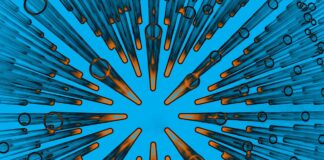Hydrogel, a versatile and remarkable material, has garnered immense attention across various industries for its unique properties and diverse applications. Comprising a three-dimensional network of hydrophilic polymers that can absorb and retain water, hydrogels exhibit a remarkable ability to mimic biological tissues, making them invaluable in fields ranging from medicine to engineering. The term “hydrogel” encapsulates a wide array of materials with varying compositions, properties, and applications, cementing its status as a staple in modern material science.
At its core, a hydrogel is a substance composed of water and a polymer network, often derived from natural or synthetic sources. The word “hydrogel” stems from the combination of “hydro,” denoting water, and “gel,” signifying a solid-like structure. This aptly describes the hydrogel’s ability to hold large amounts of water within its matrix, imbuing it with a high water content while maintaining a solid or semi-solid consistency. This distinctive characteristic enables hydrogels to swell in the presence of water, making them an ideal candidate for applications that require controlled hydration and moisture retention.
The versatility of hydrogels has positioned them as a cornerstone of innovation in multiple industries. In the realm of medicine, hydrogels have made significant contributions to drug delivery systems, wound healing, tissue engineering, and diagnostics. Their compatibility with biological tissues, coupled with the capacity to encapsulate and release therapeutic agents over time, has revolutionized drug delivery, allowing for precise administration and enhanced therapeutic outcomes. Moreover, hydrogels have played a pivotal role in tissue engineering by providing scaffolds that mimic the extracellular matrix, promoting cell growth and tissue regeneration.
In the field of ophthalmology, hydrogels have facilitated advancements in contact lenses and intraocular lenses. The hydrophilic nature of hydrogels ensures a high degree of comfort when in contact with the eye, making them an ideal material for extended-wear contact lenses. Additionally, intraocular lenses made from hydrogels have been designed to replace the natural lens during cataract surgery, offering improved visual outcomes and minimizing post-operative discomfort.
Hydrogels’ significance extends beyond the realm of healthcare into environmental applications. Their ability to absorb and retain water has found use in water purification and agriculture. Hydrogel-based materials can be employed to remove contaminants from water sources, contributing to the mitigation of water pollution. In agriculture, hydrogels are used to improve soil water retention, enabling more efficient irrigation and water management practices. This not only conserves water resources but also enhances crop yield and resilience in arid regions.
In the domain of consumer products, hydrogels have found their way into personal care items such as cosmetics, skincare products, and wound dressings. The ability of hydrogels to release moisture gradually and create a protective barrier against external factors has led to their incorporation in moisturizers, serums, and wound healing formulations. This has garnered attention from consumers seeking products that offer prolonged hydration and enhanced skin health.
The industrial sector has also embraced hydrogels for their utility in sensors, actuators, and smart materials. Hydrogel-based sensors respond to changes in environmental conditions, such as pH or temperature, by undergoing alterations in their physical properties. These sensors have applications in various fields, from healthcare diagnostics to environmental monitoring. Furthermore, hydrogel-based actuators, which can expand and contract in response to environmental cues, hold promise in soft robotics and biomedical devices, where adaptability and biocompatibility are paramount.
The evolution of hydrogel technology has spurred researchers to explore its potential in cutting-edge domains, including 3D bioprinting and tissue regeneration. By harnessing the unique properties of hydrogels, researchers can create intricate structures that resemble human tissues, paving the way for advancements in personalized medicine and regenerative therapies. The compatibility of hydrogels with living cells makes them a crucial component in the quest to develop functional tissues and organs outside the human body.
As hydrogels continue to captivate researchers, engineers, and innovators, the future holds the promise of even more transformative applications. From drug delivery platforms that target specific diseases to wearable devices that monitor health in real-time, hydrogels are poised to play an increasingly integral role in shaping the landscape of modern technology and healthcare. The journey of hydrogels from their inception to their current multifaceted applications underscores their potential to revolutionize industries, improve human health, and inspire innovative solutions to complex challenges.
Hydrophilic Polymer Network:
Hydrogels are characterized by a three-dimensional network of hydrophilic polymers that can absorb and retain large amounts of water.
Biocompatibility:
Hydrogels’ ability to mimic biological tissues and interact favorably with living cells makes them well-suited for medical applications, including drug delivery, tissue engineering, and wound healing.
Versatility and Customizability:
Hydrogels encompass a wide range of materials with diverse compositions, allowing researchers to tailor their properties for specific applications, such as controlled drug release or environmental sensing.
Moisture Retention:
The capacity to maintain high water content within their matrix makes hydrogels useful for applications requiring controlled hydration, including contact lenses, skincare products, and agriculture.
Innovation Catalyst:
Hydrogels serve as a catalyst for innovation in multiple industries, driving advancements in fields like medicine, consumer products, environmental protection, and smart materials.
The world of hydrogels unfolds like a captivating narrative, weaving together the threads of science, innovation, and practical application. This intricate material, with its ability to hold water within a matrix of polymers, has captured the imagination of researchers, engineers, and creative minds across diverse fields. Hydrogels are emblematic of the convergence of nature’s design and human ingenuity, offering a canvas upon which new solutions to old problems are painted.
In the realm of medicine, hydrogels are akin to chameleons that seamlessly blend with biological environments. Their compatibility with living cells and tissues has opened avenues for breakthroughs in drug delivery systems. Imagine a world where medications are released with precision, guided by hydrogel carriers that respond to specific triggers within the body. This level of personalized drug delivery not only enhances therapeutic outcomes but also minimizes side effects. As researchers refine hydrogel compositions and behaviors, the prospect of targeting diseases with unparalleled accuracy becomes increasingly realistic.
Wound healing, an age-old concern, has found a contemporary ally in hydrogels. Their moisture-retaining capabilities create an optimal environment for cell proliferation and tissue regeneration. By offering a soothing and protective cocoon for wounds, hydrogel dressings accelerate the healing process and minimize scarring. The synergy between hydrogels and the body’s natural healing mechanisms reflects the harmonious interplay between human biology and synthetic innovation.
The landscape of wearable technology has witnessed hydrogels stepping into the limelight as a medium for sensors and monitors. Their responsiveness to changes in pH, temperature, or other environmental factors provides a foundation for creating smart materials that can sense and adapt to their surroundings. Imagine garments that can monitor vital signs, track hydration levels, or even detect pathogens in real time. This marriage of functionality and comfort, facilitated by hydrogels, could revolutionize how we interact with technology on a daily basis.
Environmental concerns have ignited a collective search for sustainable solutions, and hydrogels are emerging as allies in this endeavor. Their capacity to absorb water holds promise for water purification systems, where hydrogel-based materials can be tailored to selectively trap contaminants from polluted water sources. This innovative approach to water treatment aligns with the global pursuit of clean water access and ecosystem preservation. Additionally, hydrogel-enhanced soil management could play a pivotal role in agriculture, reducing water waste and enhancing crop productivity in a world grappling with fluctuating climate patterns.
The world of hydrogels extends its influence into the realm of aesthetics and self-care, offering a bridge between science and beauty. Skincare formulations harness the gradual release of moisture from hydrogels, providing hydration that lasts longer than traditional products. This integration of science into daily routines speaks to the aspiration for holistic well-being, where innovation complements age-old practices.
The engineering landscape is replete with examples of hydrogels pushing boundaries. Soft robotics, a field that seeks to mimic the flexibility and adaptability of natural organisms, finds a promising ally in hydrogel actuators. These materials can expand and contract in response to external stimuli, mirroring the actions of muscles. The synergy between hydrogels and robotics hints at a future where machines can emulate the graceful movements of living beings, opening avenues for applications in medical devices, prosthetics, and beyond.
The artistic potential of hydrogels is as captivating as their functional applications. Creative minds explore the interplay between form, light, and hydrogel properties to craft immersive installations that respond to human interaction or environmental changes. These artistic explorations blur the lines between science and art, inviting audiences to contemplate the intricate dance of materials and perception.
In the grand tapestry of scientific progress, hydrogels have carved a distinct path, challenging traditional boundaries and offering fresh perspectives on age-old questions. The symphony of innovation, ethics, and societal impact is interwoven within the fabric of hydrogel research and applications. As we continue to unravel their potential, we are reminded that the narrative of hydrogels is far from linear—it is a narrative that unfolds with each experiment, each breakthrough, and each new collaboration. It is a narrative that embodies the human spirit of inquiry and the boundless possibilities that arise when we dare to explore the unknown.














